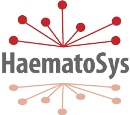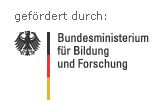HaematoSys
Systembiologie der Hämatopoese und hämatopoetischer Neoplasien
SUBPROJECT 2 - MODELLING ONCOGENE DEPENDENT MOLECULAR MECHANISMS IN LYMPHOMA-GENESIS
Coordinator: Rainer Spang
Partners receiving funds: D. Kube (DK) , F. Horn (FH), K. Strimmer (KS), J.Läuter (JL), U. Mansmann (UM), R. Spang (RS)
Associated partners: L. Trümper (Göttingen) for the MMML-Consortium, A.Rosenwald (Würzburg)
Overall Description of the Subproject
Background and own contributions: Well known oncogenes involved in the development of lymphomas like MYC, BCL6, STAT3 and p65/NFkB intervene in molecular mechanisms of lymphocytes contributing to the malignant transformation of these cells. Their molecular action can only be understood in the context of their interplay due to cross talk of pathways. A first set of models aims at elucidating the structure of oncogenic pathway cross talk. We will analyze this network both on the non-transcriptional and the transcriptional level. While in principal these four oncogenes can contribute to lymphoma genesis, not all of them are jointly active in all lymphomas. Most likely, the constellation of oncogene activities is crucial for the biology of a lymphoma and has an impact on treatment success. We have developed statistical systems biology methodology, which paved the way to integrate functional and clinical data into network models of lymphoma genesis. This methodology includes the Nested Effects Models for analyzing non-transcriptional signalling pathways pioneered by the Spang group [3.21-3.22] and statistical learning procedures for high-dimensional genetic networks [3.19-3.20]. The methodology is complemented by rigorous statistical procedures developed in the groups of JL and UM. Both the existing lymphoma data and the expertise in statistical models of non-transcriptional signalling and network validation are unique in the world.
Objective: We will develop molecular models of lymphoma genesis, which are reproducible and validated. Moreover, we will develop models, which will allow us to characterize lymphomas with respect to the activity of oncogenes and proto-oncogenic pathways.
Available data: In the research network Molecular Mechanisms of Malignant Lymphoma (MMML), we have generated the data foundation for a systems level analysis of molecular deregulation in mature aggressive non-Hodgkin lymphomas [3.25]. More than 600 lymphomas were characterized by genome wide profiles of gene and miRNA expression, genetic variability (SNP and mCGH) and methylation pattern. The genomic data is complemented by Fish analysis, extended immunochemistry, panel pathology and clinical follow up.
Work Plan: Experiments For systems level analysis, we will complement the existing MMML data by generating template expression profiles of oncogene activity using functional assays involving targeted molecular perturbations, including RNAi silencing of oncogenes in lymphoma cell lines as well as stimulation assays of proto-oncogenic pathways in primary germinal centre B-cells. These profiles monitor down stream effects of oncogene pathway perturbations, reflecting the hierarchical structure of underlying pathways. We will perform transient silencing assays (RNAi) of MYC, BCL6, STAT3 and p65-NFkB in 3 Burkitt lymphoma cell lines (BL2, BL70, Ramos), 3 DLBCL-ABC cell lines (OCI-Ly2, SuDHL-4, SuDHL-10) and 3 DLBCL-GCB cell lines (OCI-Ly3, SuDHL-2, HBL1) and will subsequently record transcriptional down stream effects on Affymetrix microarrays. We will also target all pairs of the four oncogenes simultaneously. These experiments will be performed by FH and DK. Complimentarily to inhibiting active pathways in cell lines, we will also stimulate oncogenic pathways in lymphoma precursor cells, were these pathways are a priori inactive. More precisely, we will isolate germinal centre B-cells from the tonsils of five different children and will stimulate II-4, CD40 and BCR (weak stimulation) thus activating the proto-oncogenic JAK-STAT, NFkB and BCR signalling pathways. Genome wide expression will be monitored at 9 time points (e.g. 0, 30, 60, 90, 120, 150, 180, 210 and 240) minutes after stimulation. These experiments are performed by DK.
Pathway and Network Modelling. This modelling proceeds along several lines. The Spang group will use nested effect models (NEM). NEM draw information on the wiring of signalling pathways in the cytosol through the nesting of downstream effects induced by perturbing signalling molecules [3.21],predicting a cells response to external intervention. We will apply NEM to derive the cross talk network of oncogene inducible pathways. We will identify transcriptional modules (sets of co-regulated genes), which are affected by mutual modulation of the interacting pathways. Furthermore, we will apply active learning in NEM to iteratively identify additional oncogenic targets for silencing assays from the current state of the model, thus continuously validating, updating and improving the network. Recent improvements in nested effects modelling enable us to analyze up to 15 oncogenes simultaneously [3.22-3.23]. Nevertheless, these models recover steady states and can not address the dynamics of pathway interaction. The Spang group is currently developing dynamic NEM (time lag models), which we will apply to model the mutual modulation of proto-oncogenic pathways, early after stimulation (no steady state). High-dimensional time-series data of pathway stimulation will be modelled by KS. These methods [3.16-3.18] allow the inference of causal relations between the investigated genes. Additionally, DNA-protein binding effects can be explicitly incorporated into the model [3.15], as are explicit dynamics and feedback mechanisms [3.14]. In addition, alternative time-series methods based on novel tests for high-dimensional correlated data will be applied by JL in Leipzig. We will model individual transcriptional networks for Il-4, CD40 and BCR stimulation and will compare these methods through novel method for detecting significant changes in transcriptional regulation recently developed by UM. The bridge to the MMML data and thus to translational research in clinical settings is built through models integrating both functional and clinical lymphoma data. Building on our recent results in Bentink et al 2008 (submitted), we will predict the constellation of oncogene/oncopathway activity in individual lymphomas. We will use semi-supervised classification models [3.25] to detect conservation of functional dysregulation patterns in the MMML lymphoma data, thus stratifying a large lymphoma cohort from the perspective of oncogene activity and linking to the dynamic model in SP3.
Model Validation. We will validate our results both experimentally and through rigorous methods of statistical inference. Array data will be validated by real-time PCR of 5 representative model driving gene expression changes per analysis. The group of JL has recently developed algorithms for identifying coregulated gene sets in high-dimensional settings. Both non-parametric methods extending the Westfall-Young framework as well as parametric spherical models are available and will be applied. Oncogene dependent changes in transcriptional networks will be tested through novel methods of testing high dimensional multivariate distributions developed by the group of UM. Special emphasis will be given to measures of uncertainty associated with the network structures, which will allows us to focus on reliable network features and avoid traps set out by algorithmic artefacts. NEMs will be evaluated through their predictive accuracy in cross-validation as well as through independent test data from 30 additional arrays generated after completion of the models. In addition to the predictive performance, the stability of complete networks as well as single network features will be evaluated through non-parametric bootstrap analysis. Clinical relevance of the oncogene activity models in real lymphomas will be assed through the MMML data on other omics- levels. Moreover, we will evaluate the diagnostic and prognostic potential of our models through survival analysis using the existing clinical follow up data of the MMML study.

